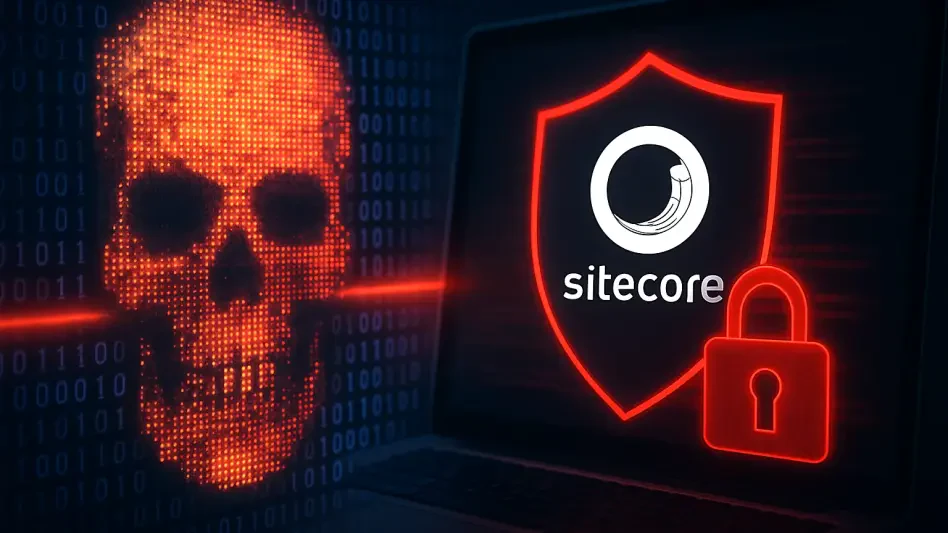What happens when a trusted tool for building digital experiences becomes a gateway for catastrophic cyberattacks? A recently discovered zero-day vulnerability in Sitecore, a leading content management platform, has sent shockwaves through the cybersecurity community, leaving countless systems at risk. Identified as CVE-2025-53690, this flaw—rooted in exposed ASP.NET machine keys from vendor documentation—has left systems vulnerable to remote code execution (RCE). As enterprises worldwide rely on Sitecore to manage critical data and customer interactions, the stakes couldn’t be higher. This silent threat, lurking in plain sight, demands immediate attention from every organization using the platform.
Why This Vulnerability Matters
The significance of this flaw cannot be overstated. Sitecore powers the digital backbone of major corporations, from retail giants to financial institutions, through products like Experience Platform, Experience Manager, and Experience Commerce. A vulnerability of this magnitude, affecting versions as early as 9.0 and spanning multi-instance deployments, threatens not just isolated systems but entire business ecosystems. The core issue—static machine keys provided in deployment guides—turns a routine configuration step into a potential disaster, exposing organizations to data breaches, malware, and operational shutdowns.
This isn’t a hypothetical risk. Real-world exploitation has already been documented, with attackers leveraging the flaw to devastating effect. The widespread use of these sample keys among Sitecore customers amplifies the danger, creating a vast attack surface that cybercriminals are eager to exploit. As the digital landscape grows more complex, such oversights in software security serve as a stark reminder of the fragility of even the most trusted platforms.
The Flaw Exposed: A Blueprint for Attackers
At the heart of this vulnerability lies a deceptively simple error: many users have directly copied sample machine keys from Sitecore’s deployment guides, available for at least eight years, instead of generating unique, secure ones. These static keys, meant as placeholders, enable attackers to conduct ViewState deserialization attacks, a technique that allows remote execution of malicious code. The result? Full control over compromised systems with minimal effort.
Mandiant Threat Defense uncovered active exploitation by an unidentified attacker who used these exposed keys to deploy malware for internal reconnaissance. The sophistication of the attack was evident as the adversary escalated privileges, moved laterally across networks, and siphoned off sensitive data. Although Mandiant, in collaboration with Sitecore, disrupted the operation, the incomplete observation of the attack lifecycle leaves lingering concerns about undetected compromises and the true scope of the damage.
The risk footprint is staggering. With no clear data on how many organizations adopted these sample keys, the potential for widespread impact looms large. This incident underscores a critical lesson: even minor configuration missteps can open the door to catastrophic breaches in an era where attackers meticulously hunt for such weaknesses.
Experts Weigh In: A Shared Responsibility
Cybersecurity professionals have been quick to dissect this issue, pointing to dual accountability. Ryan Dewhurst from watchTowr emphasized, “Reusing public machine keys is a glaring oversight, but vendors must shoulder some blame for not explicitly flagging this danger in their guides.” This perspective highlights the need for clearer warnings in documentation to prevent such pitfalls.
Caitlin Condon of VulnCheck offered a broader view, stating, “Attackers are increasingly mining vendor resources for exploitable errors—Sitecore is just one example in a growing trend.” Her insight reveals a troubling reality: documentation meant to assist users can become a roadmap for adversaries if not handled with caution. The consensus among experts is clear—both users and vendors must adapt to counter the evolving tactics of cybercriminals.
Beyond individual responsibility, this situation raises questions about industry practices. How many other platforms harbor similar flaws in their guidance materials? The stealth of the attacker, as noted by Mandiant, only deepens the urgency for systemic change in how software configurations are communicated and secured.
The Anatomy of the Attack: A Sophisticated Threat
Delving deeper into the exploitation, the attacker’s approach showcased a profound understanding of Sitecore’s architecture. After gaining initial access through the flawed machine keys, the adversary deployed a ViewState payload laced with malware, setting the stage for reconnaissance. This allowed them to map out internal systems and identify high-value targets within the network.
Subsequent steps revealed even greater intent—privilege escalation enabled deeper access, while lateral movement facilitated control over multiple systems. Persistence mechanisms ensured the attacker could maintain a foothold, even as they exfiltrated sensitive data. Such tactics illustrate not just technical prowess but a calculated strategy to maximize damage before detection.
What makes this particularly alarming is the anonymity of the threat actor. Without a full picture of their motives or origins, organizations remain in the dark about potential follow-up attacks. This gap in intelligence emphasizes the need for robust monitoring and rapid response capabilities to counter such advanced threats.
Steps to Secure Your Environment
For Sitecore users, the path forward requires immediate and decisive action. Start by auditing deployments to identify whether a known or sample machine key is in use—if so, rotate it to a unique, secure key without delay. This step alone can close the primary entry point exploited by attackers.
Beyond key rotation, proactive monitoring for signs of ViewState deserialization attacks is essential, though it won’t address systems already breached. Additionally, organizations with multi-instance setups must ensure no static keys are shared across environments, as this amplifies exposure. A broader shift in mindset is also critical—vendor-provided examples should never be used verbatim; customization is key to avoiding such vulnerabilities.
Finally, consider this incident a wake-up call to scrutinize all software configurations, not just for Sitecore. Engage with cybersecurity teams to establish rigorous checks and adopt best practices that prioritize security over convenience. In a landscape where attackers thrive on oversight, diligence is the strongest defense.
Reflecting on a Wake-Up Call
Looking back, this zero-day vulnerability in Sitecore exposed a critical gap in software security that caught many off guard. The exploitation by a sophisticated attacker revealed how even trusted documentation could become a weapon in the wrong hands. Organizations scrambled to assess their exposure, while experts called for accountability on all fronts.
Moving ahead, the focus shifted to prevention through actionable measures—rotating keys, enhancing monitoring, and rethinking reliance on vendor examples. This incident also sparked a broader dialogue about the role of vendors in safeguarding users against configuration pitfalls. As threats evolve, adopting a proactive stance became non-negotiable.
Ultimately, the lessons learned paved the way for stronger defenses. Enterprises were urged to invest in continuous security assessments and collaborate with industry peers to stay ahead of emerging risks. By turning this breach into a catalyst for change, the hope was to build a more resilient digital future where such oversights no longer handed attackers the keys to chaos.








